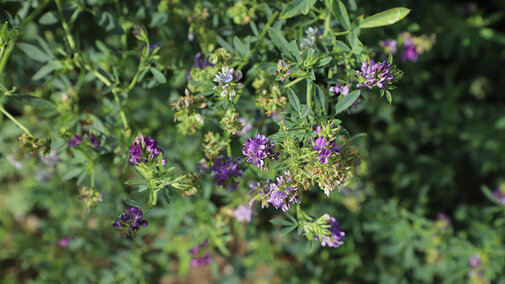Evaluating Fall Alfalfa Stands
Were you expecting more from your alfalfa yields from the first cuttings? Is it time to renovate, start over or move on? Typically, evaluating alfalfa stands occurs in spring, but checking out those areas this fall will give you more time for weighing options going forward.
There are two options when evaluating your stand: First, by the number of plants per square foot (typically recommended for newer stands) and second, by the number of stems, for established stands. University of Wisconsin research shows that stem count more accurately predicts yield compared to plant number; however, either method will provide information that can be useful for making management decisions.
To determine the number of plants or stems per square foot, I recommend using a hay square. Your hay square should measure 17x17 inches square or a 19-inch diameter circle. A quick and cheap option is to build one out of ½-inch PVC and some 90-degree corners. If you can find a hula hoop that is 19 inches in diameter, that works too, but be prepared for some funny looks as you measure hoop diameter in the store.
Pick five random areas in your field to sample. Then count the plants or stems that would be harvested. Typically, anything over six inches in height qualifies to determine your count. Next, divide those numbers in half to get stems or plants per square foot. For established stands, having four to five healthy plants per square foot or 55 stems per square foot would warrant a productive and healthy stand. Stem counts below 55 see a significant decrease in dry matter production. For spring established stands, 10-15 plants per square foot is a perfectly healthy stand as the alfalfa begins to age. Plants will continue to branch out, so 35-55 stems per square foot is the goal at this point.
Evaluate your alfalfa stand this fall to determine needs for spring. For established stands, four to five plants and 55 stems per square foot are good, while new stands should have 10-15 plants or 35-55 stems per square foot. If your stand is below these thresholds, we need to start weighing our options.
Adding Grass to Thinning Alfalfa
Do you have a thinning and low-producing alfalfa stand but are not quite ready to do a complete reseeding? These stands can be rejuvenated by interseeding grasses to increase hay production in subsequent years or to convert them to pasture.
Most alfalfa fields start to lose stand and production potential after cutting hay for several years. Orchardgrass is the grass most commonly interseeded into alfalfa, but other grasses like endophyte-free tall fescue, smooth or meadow brome, festulolium and wheatgrasses also can be used. In fact, if the field will be used as pasture, a mixture of several grasses may be best since it adds diversity to your animals' diet.
Interseeding after a mid- to late August hay harvest can be excellent timing if you have moisture to start the new seedlings. Alfalfa regrows more slowly this time of year so it won’t compete as aggressively with your new grasses. Still, if your alfalfa is relatively thick, you probably will need to take another cutting in about four weeks, or as soon as the alfalfa starts to form a full canopy. This allows sunlight to continue to reach new grass seedlings below the alfalfa.
The seeding rate of the grasses will vary depending on the species that is used and how thick the existing alfalfa is. With orchardgrass, for example, as little as 3 lb./acre might be adequate in a relatively thick alfalfa stand or up to 6 lb./acre in a very thin alfalfa stand.
Next spring you will need to judge how well established your new grasses have become. If they seem a little weak, cut hay early to again open the canopy for better light penetration. After that, you should be able to hay as you choose, but keep in mind that grass regrowth in the heat of the summer will be less than that of the alfalfa.
Inoculants for Corn Silage
By Brad Schick
Silage is only as good as we can harvest and store it, but then we also need to feed it. Adding inoculants might be one way to help, and it’s not too early to figure out which one would be best.
Inoculants are simply bacterial cultures that help reduce pH faster by converting sugars to acids which reduce molds, fungi and unwanted bacteria such as clostridia.
According to a leading expert in silage inoculants, Dr. Limin Kung, University of Delaware ruminant nutrition specialist, the first step is deciding if upfront fermentation and/or aerobic stability are needed when feeding the silage. Typically, when discussing corn silage, both are needed. Some inoculant brands include Lallemand, Pioneer and SuperSile. Just to name a few.
Inoculants primarily reduce storage losses. The most effective ones contain homolactic acid bacteria such as Lactobacillus plantarum. Fermentation starts and ends quicker with inoculated silage, so more silage remains for feeding. Some inoculants, like heterolactic acid bacteria Lactobacillius buchneri, can improve aerobic stability by reducing spoilage losses when silage is re-exposed to air. These bacteria are especially useful at reducing spoilage on the face of bunker silos if the face is too wide to keep fresh or if producers take out several days’ worth of feed from the pile at one time.
The purpose of inoculants is not to fix a train wreck or improve a perfect silage year, but they can help when things aren’t ideal. Inoculants can be used as an insurance policy to reduce the risk of spoilage and maintain quality. This insurance policy, however, can be used on a year-by-year basis unlike most insurance decisions.

